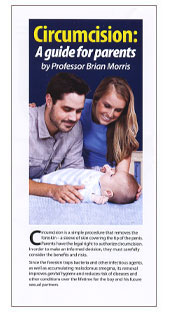Circumcision and Anesthesia
In the past, anesthesia was not advocated for infant circumcision. The reasons included: (1) unfamiliarity with use and side effects of anesthetics in infants, (2) belief that the procedure caused little or no pain in this age group, and (3) belief that pain from injection of anesthetic was as bad as the pain of the surgery [Wellington & Rieder, 1993]. In contrast to circumcision, pain management for vaccine injection, the most common iatrogenic procedure performed in childhood, remains inadequate, yet is seldom raised as an issue, whereas, like circumcision, it should be [Taddio et al., 2009].
It is now known that infants do experience pain [Porter et al., 1999], and anesthesia for circumcision is recommended [Rabinowitz & Hullbert, 1995; Maxwell & Yaster, 1999]. Nevertheless, it is also known that neonates exhibit low pain scores compared with older infants [van Dijk et al., 2001]. Indeed, a baby must be quite resilient to endure the pain of passing through the narrow birth canal during parturition. In this regard, response to pain is lower in infants following vaginal delivery than delivery by caesarian section [Bergqvist et al., 2009]. “Pain and stress reactivity appear to be inhibited during fetal life”, leading to the suggestion that “to minimize neonatal pain, we recommend that postnatal invasive procedures be performed shortly after vaginal birth”, namely “within 90 min after birth” [Bergqvist et al., 2009].
In mice, early exposure to noxious or stressful stimuli decreases pain sensitivity and behavior in adult life, possibly by altering the stress-axis and antinociceptive circuitry [Sternberg et al., 2005; Laprairie & Murphy, 2009].
Pain management for pediatric patients has, moreover improved over the years and can involve a multidisciplinary approach to compliance to a topical analgesia protocol [Cregin et al., 2008].
Local anesthesia is all that is required or this simple procedure. General anesthetics present unnecessary risks, including neurotoxicity that may affect the development of neuronal structures (see review: [Mancuso & Burns, 2009]). This adds to general advice that circumcision is best done using a local anesthetic early in infancy when the infant is less mobile.
Dorsal penile nerve block [Kirya & Werthmann, 1978] represents 85% of anesthetic use in the USA [Warner & Strashin, 1981] and is effective [Howard et al., 1999], even in low birth-weight infants [Holliday et al., 1999]. It involves injection of local anesthetic at the 10 and 2 o’clock positions at the base of the penis, where the dorsal penile nerve is situated. Allowing the infant to suckle from a gloved human finger further decreased measured pain responses during dorsal penile nerve block [South et al., 2005]. The method is regarded as useful, with a failure rate of only 4–7%, a very low incidence of complications, which if they occur tend to be minor [Goulding, 1981]. A prospective, randomized, controlled, double-blind trial found caudal block using 0.5 ml per kg 0.25% bupivacaine with 0.5 mg per kg ketamine gave a longer duration of analgesia than penile block with 0.25 ml per kg 0.5% bupivacaine [Margetts et al., 2008]. Tramadol (5%) plus adrenaline was more effective than 2% prilocaine plus adrenaline during and after circumcision of children [Kargı et al., 2009]. A portable ultrasound scanner can be used to guide dorsal penile nerve block [Sandeman & Dilley, 2007]. Scanning can then confirm correct placement of the local anesthetic and its spread to contact the deep fascia on each side. Inadvertent injection into the corpora cavernosa, urethra and neurovascular bundle are thereby avoided. An isolated report describes an extremely rare case of ischemia in the hours after an adult circumcision and this could be reversed quickly and simply [Tzeng et al., 2004].
Ring block, which has also long been used for post-circumcision analgesia [Broadman et al., 1987], is simpler, and extremely effective [Lander et al., 1997; Hardwick-Smith et al., 1998; Matsota & Papageorgiou-Brousta, 2004]. This procedure involves injection of a local anesthetic around the circumference of the penis at the mid-shaft level. In fact ring block may be the best. Further technical information can be found in ref: [Ross et al., 2000]. Pain from the infiltration of a local anesthetic is short-lived and significantly less than the pain from an un-anesthetized circumcision [Lander et al., 1998].
Combining dorsal penile nerve block and ring block is more effective than either alone in reducing post-circumcision pain in children aged 1 month to 5 years [Naja et al., 2005].
Dr Sam Kunin in Los Angeles has developed a clever method in which local anesthetic is injected into the distal foreskin which separates the inner and outer foreskin so allowing the inner layer to be pulled against the bell of a Gomco clamp, and results in a maximum amount of inner layer being removed (http://www.samkuninmd.com). He points out that the inner lining is the area most prone to adhesions, irritations, yeast and bacterial infections, particularly in diabetics.
EMLA cream (5% lidocaine/prilocaine; AstraZeneca) reduces pain during circumcision [Taddio et al., 1997a; Taddio et al., 1997b; Woodman, 1999], and blood sampling in newborn babies [Ramet et al., 1997], but is less effective than the others [Lander et al., 1997; Butler-O'Hara et al., 1998; Garry et al., 2006]. Rises in met-hemoglobin 3.5 to 13 hours after application of EMLA cream are well below potentially harmful levels [Law et al., 1996; Brisman et al., 1998]. In a double-blind, randomized, placebo-controlled trial there was no change in met-hemoglobin concentration after EMLA cream [Taddio et al., 1997b]. Epicutaneous EMLA is more effective than 30% lidocaine [Woodman, 1999]. Lidocaine 4% cream has similar efficacy as EMLA [Lehr et al., 2005].
No increase in the acute phase protein C-reactive protein (CRP) occurs after circumcision by general or local anesthesia [Buyukkocak et al., 2005].
Pacifiers, especially with glucose or sucrose, are also effective (pain score = 1 as opposed to 7 with placebo) [Carbajal et al., 1999]. Infants circumcised with the Mogen clamp and combined anesthesia (lidocaine dorsal penile nerve block, lidocaine-prilocaine, acetaminophen, and sugar-coated gauze dipped in grape juice), with 55 seconds taken for the procedure, showed substantially less pain than those circumcised with the Gomco clamp and EMLA cream, which took 577 seconds for the procedure [Taddio et al., 2000]. A literature review supports the analgesic benefit of sucrose for alleviation of minor procedural pain [Tsao et al., 2008].
Music can also be used for pain relief [Cepeda et al., 2006; Hartling et al., 2009].
Tetracaine gel is another topical agent and is as effective as EMLA cream, but only needs to be applied for 30 min, as Tetracaine gel is another topical agent and is as effective as EMLA cream, but can be applied for only 30 min, compared with 60 min, prior to circumcision [Taddio et al., 2002].60 min, prior to circumcision [Taddio et al., 2002].
As mentioned in the previous section, a simple, effective procedure has been described by Dr Terry Russell, OAM, in Brisbane, Australia [Russell & Chaseling, 1996] and is the subject of a teaching video. The technique involves applying EMLA cream thickly to the distal penis 2 hours prior to the procedure. The penis is wrapped in cling-wrap to keep the cream in contact with the penis, but with the end left open to allow for urination. The Plastibell device is then used. The baby does not cry. In those aged less than 7 months, 99% fed immediately afterwards, 96% settled rapidly, 97% had no disturbance of sleep pattern, 93% had little or no apparent pain, and 96% had no pain or difficulty when urinating. None required stronger post-operative analgesia than paracetemol. In fact Russell claims that virtually no pain is experienced following the surgery, unlike other methods. He attributes this to the 2 hour duration of the EMLA cream prior to surgery, which means 5 hours of analgesia post-operatively, by which time the nerves where the ligature was tied have ceased to function, and says that most doctors do not leave the EMLA cream on long enough before commencing the procedure (Terry Russell, personal communication).
Postponing circumcision until the child is suitable for general anesthesia has been rejected strongly [Russell & Chaseling, 1996]. Total pain control can of course be achieved by a general anesthetic. This can be given routinely for very young children, and if done in a children's hospital there is virtually no risk. However, because the operation is so trivial technically, local anesthesia is all that is required.
For a minority of people the way the circumcision is performed will obviously be dictated by their cultural or religious beliefs. It is, moreover, acknowledged that for Jews the traditional bris might be less traumatic than common institutional approaches [Lander et al., 1998]. Jewish Mohelim take 10 seconds, with 1 second for excision, and 60 seconds on average for crying; since there is no crushing of tissue, the pain is claimed to be not as severe as techniques used by doctors [Shechet et al., 1998].
Despite the benefits and proven safety of anesthesia, studies in the early 1990s found that many male newborn circumcisions in North America did not involve anesthetics and this was as much as 64–96% in some regions [Toffler et al., 1990; Wellington & Rieder, 1993]. "Given the overwhelming evidence that neonatal circumcision is painful and the evidence of safe and effective anesthesia/analgesia methods, residency training in neonatal circumcision should include instruction of pain relief techniques" [Howard et al., 1998].
A 1998 survey found that in the USA 84% of pediatric, 80% of family practice and 60% of obstetric programs do indeed teach anesthesia/analgesia techniques [Howard et al., 1998]. Another survey in the USA that year found it was thus surprising that 71% of pediatricians, 56% of family practitioners, and only 25% of obstetricians were found to use analgesia/anesthesia [Stang & Snellman, 1998]. A survey in 2006 found 82% of training programs taught circumcision and of these 97% taught the administration of anesthetic, either locally or topically [Yawman et al., 2006]. The breakdown by specialty and type of anesthetic is given in this article. Use of pain relief always or frequently in residency programs that teach circumcision was, however, only 84% topically [Yawman et al., 2006].
In adults, a randomized controlled trial found that subcutaneous infusion of ketamine at the incision site prior to circumcision under general anesthesia reduced postoperative pain [Tan et al., 2007].
A study in Greece found that children undergoing circumcision do not require routine admission to a post-anesthesia care unit, and can be transferred to the ward directly [Micha et al., 2009].



